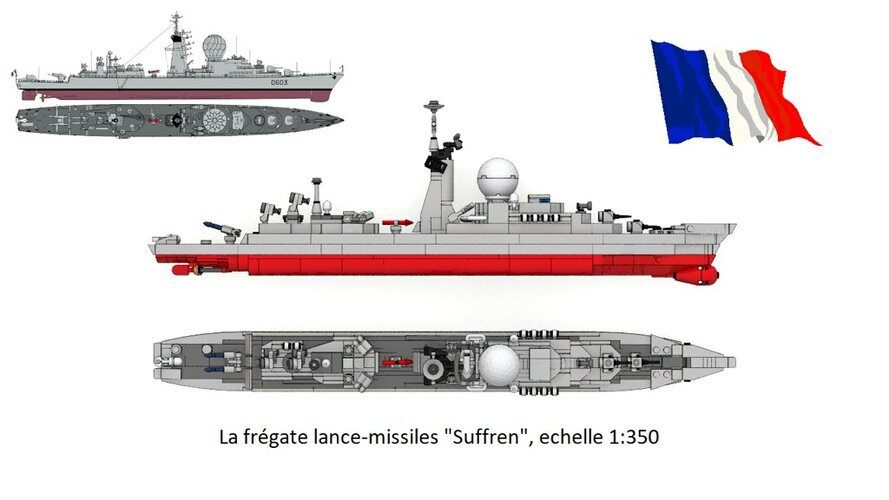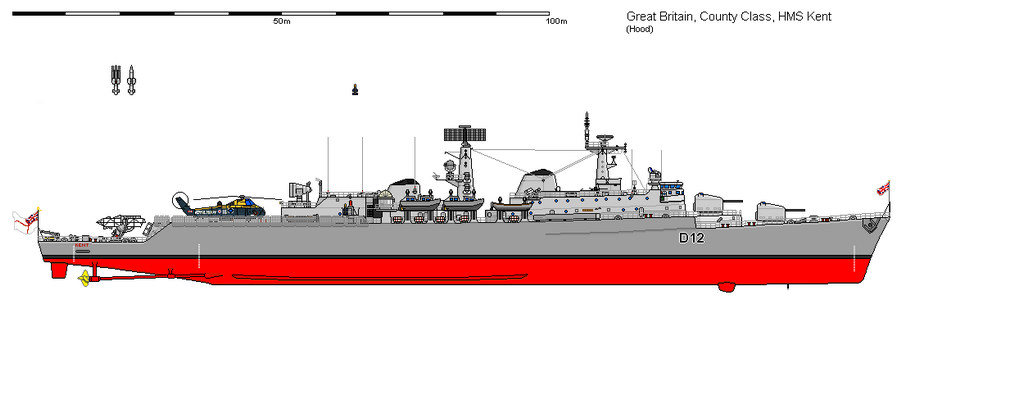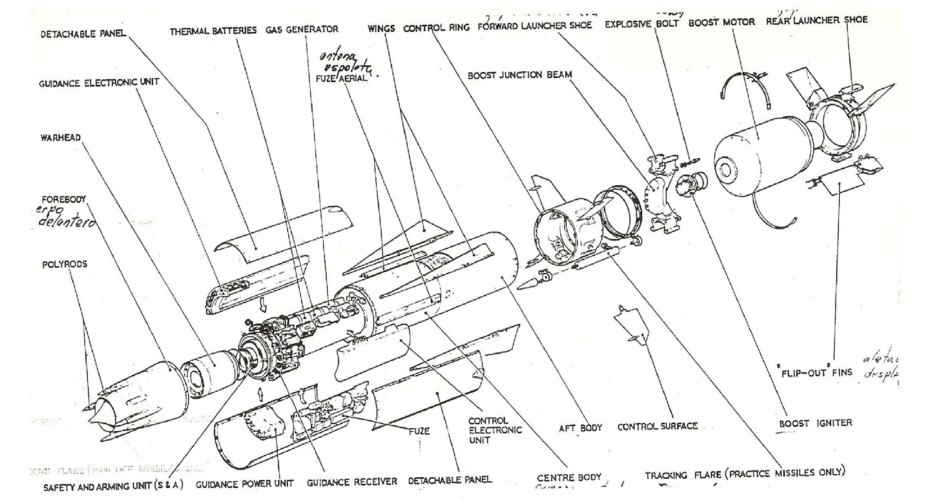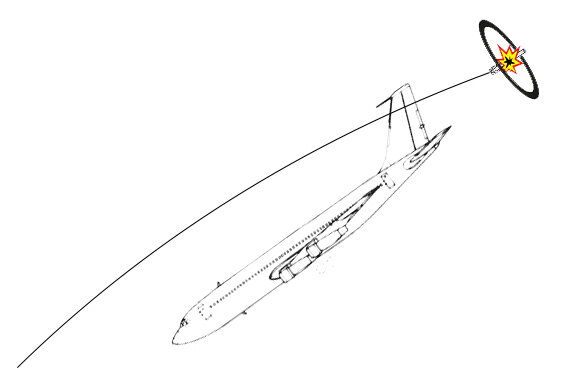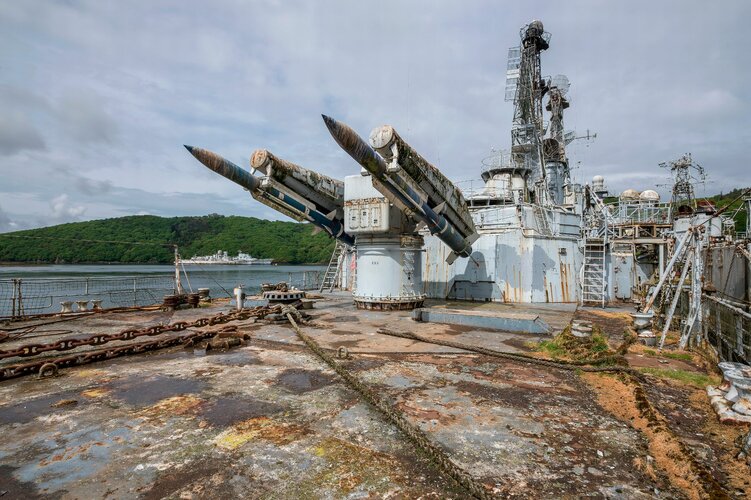Could be, as far as i can remember, the fire control computers shut down quite a few times during aerial attacks with horrible consequences. This affected both Sea Dart and Sea Wolf (Sea Cat suffered from other issues).I was once told “had it not been for just two lines of computer code it could have been double.” ;- I assume the cause of the infamous system trip outs but I have no validation if the that’s correct.
You are using an out of date browser. It may not display this or other websites correctly.
You should upgrade or use an alternative browser.
You should upgrade or use an alternative browser.
Most successful naval SAM?
- Thread starter Maury Markowitz
- Start date
pathology_doc
ACCESS: Top Secret
- Joined
- 6 June 2008
- Messages
- 1,587
- Reaction score
- 1,507
The solutions are similar but different - the French maintained spacing between the wing-strakes and the tailfins for some reason but both look very Terrier-like. The shape of the fins on the booster is different. Whoever did the work on the boost phase for Masurca evidently came to a different conclusion for whatever reason, but I don't know enough about the practical aspects of missile aerodynamics to deduce the reasons for the choices.More like Terrier.The RIM-2 Terrier entered service on June 15, 1956 on the USS Boston.Missiles entered service in the late 50s with the USN
Wasn't the Masurca basically a Tartar clone? It certainly looked like a Tartar.France had Masurca
Terrier:
View attachment 662806
Masurca:
View attachment 662807
Did not look up relative dimensions/weights.
(The missile-booster interface looks different on the Terrier displayed, but this appears to be some sort of ship-specific presentation missile and may not be representative of general-issue live rounds).
- Joined
- 27 May 2008
- Messages
- 1,178
- Reaction score
- 2,483
- Joined
- 3 June 2011
- Messages
- 18,335
- Reaction score
- 12,233
Despite it's chunkier look Masurca was longer than Terrier/RIM-67 and weighed 50% more. Big missile.The solutions are similar but different - the French maintained spacing between the wing-strakes and the tailfins for some reason but both look very Terrier-like. The shape of the fins on the booster is different. Whoever did the work on the boost phase for Masurca evidently came to a different conclusion for whatever reason, but I don't know enough about the practical aspects of missile aerodynamics to deduce the reasons for the choices.More like Terrier.The RIM-2 Terrier entered service on June 15, 1956 on the USS Boston.Missiles entered service in the late 50s with the USN
Wasn't the Masurca basically a Tartar clone? It certainly looked like a Tartar.France had Masurca
Terrier:
View attachment 662806
Masurca:
View attachment 662807
Did not look up relative dimensions/weights.
(The missile-booster interface looks different on the Terrier displayed, but this appears to be some sort of ship-specific presentation missile and may not be representative of general-issue live rounds).
- Joined
- 27 September 2006
- Messages
- 6,417
- Reaction score
- 6,815
Nice! Where did you get the diagram from?A better view of the SDView attachment 662815
Archive from the Argentine type 42s (Manual/informative piece?), the Spanish writing on top kinda gives it awayNice! Where did you get the diagram from?A better view of the SDView attachment 662815
Do you have a URL to it?Archive from the Argentine type 42s
I have a couple of pages from the pdfs, If i find them complete I’ll post them. It’s all in Spanish thoDo you have a URL to it?Archive from the Argentine type 42s
EDIT: if you give me a few days I’ll translate a few pages regarding the Sea Dart operation and specs
Last edited:
Maury Markowitz
From the Great White North!
- Joined
- 27 February 2014
- Messages
- 192
- Reaction score
- 144
Interesting, I had no idea it saw that much use.
Ah, forgetting the second highest scoring naval SAM to date with six kills*, the mighty Sea Wolf
I was once told “had it not been for just two lines of computer code it could have been double.” ;- I assume the cause of the infamous system trip outs but I have no validation if the that’s correct.
That's what you get for using COMAL.
Maury Markowitz
From the Great White North!
- Joined
- 27 February 2014
- Messages
- 192
- Reaction score
- 144
In one amusing example, they decided to put HMCS Huron to rest as part of the annual "Operation Trident Fury" (anyone else miss the Rainbow Code era?). The Canadian Navy's finest lined up like the French fleet at Trafalgar to each have a go, with HMCS Saskatchewan in the lead. One by one all of her weapons systems failed, leaving only Sparrow. The captain's comments were not at all confidence-inspiring - he seemed more like a grumpy senior citizen who's missed the Tuesday $10 all-you-can-eat buffet than the captain of a warship.Have any of them been used in an anti ship capacity? Because naval SAMs such as the Sea Sparrow and Standard have a secondary anti ship role.
Desperate not to leave the line having done nothing, she shot a Sparrow at the poor Huron. Now I have to admit, it was impressive. The JVC pops it up above the ship, not far, and tilts it over. After a brief delay the main fires. WOW! It immediately accelerates horizontally to something like Mach 2, does a neck-snapping pull-down to get back to the waterline and then hits the ship. The entire engagement after JVC ejection was a couple of seconds tops.
- Joined
- 15 July 2007
- Messages
- 4,887
- Reaction score
- 4,550
Please tell me you didn't misspell COBOL!!!!Interesting, I had no idea it saw that much use.
Ah, forgetting the second highest scoring naval SAM to date with six kills*, the mighty Sea Wolf
I was once told “had it not been for just two lines of computer code it could have been double.” ;- I assume the cause of the infamous system trip outs but I have no validation if the that’s correct.
That's what you get for using COMAL.
An extract that talks about the Sea Dart:
"The missile had a longitude of 11 feet (14 with the starter motor Aprox), the missile itself weighed 1230lb (640 without the starter motor).It had fixed lift fins and mobile ones for control.
The "air duct" of the Ramjet engine went trough all the missile's longitude, this meant that all the components and equipment were contained on the space where the air conduit didn't interfiere or in what was called the "central island", that was in the central part that also didn't interfiere with the passing of the air.
The maximum time on flight was 90 seconds (aprox), with an average range of 35miles. Regarding the Warhead this was activated via a terminal system type Fuze VT, who's sensibility could had been controlled on flight by the SDQP computer. The WarHead itself was of the "Continuous rod" type, the lethality of it was heavily dependent on the effect caused by the radial ejection of a steel bar, formed by 286 rods, that upon its explosion it formed a "ring" with a radius of 27 feet that projected itself in a perpendicular plane to the trajectory."
The Warhead workings kinda explain the phenomenon that happened during 1982, that involved a couple of Sea Darts being fired against an Argentine Air Force Boeing 707, specifically one of those missiles passed extremely close to the tail of the aircraft and exploded afterwards, the 707 wasn't hit by the warhead's rods, possibly as the explosion sent all debris perpendicular to its flight path and away from the plane.
EDIT: sorry if my translation is a bit..broken
"The missile had a longitude of 11 feet (14 with the starter motor Aprox), the missile itself weighed 1230lb (640 without the starter motor).It had fixed lift fins and mobile ones for control.
The "air duct" of the Ramjet engine went trough all the missile's longitude, this meant that all the components and equipment were contained on the space where the air conduit didn't interfiere or in what was called the "central island", that was in the central part that also didn't interfiere with the passing of the air.
The maximum time on flight was 90 seconds (aprox), with an average range of 35miles. Regarding the Warhead this was activated via a terminal system type Fuze VT, who's sensibility could had been controlled on flight by the SDQP computer. The WarHead itself was of the "Continuous rod" type, the lethality of it was heavily dependent on the effect caused by the radial ejection of a steel bar, formed by 286 rods, that upon its explosion it formed a "ring" with a radius of 27 feet that projected itself in a perpendicular plane to the trajectory."
The Warhead workings kinda explain the phenomenon that happened during 1982, that involved a couple of Sea Darts being fired against an Argentine Air Force Boeing 707, specifically one of those missiles passed extremely close to the tail of the aircraft and exploded afterwards, the 707 wasn't hit by the warhead's rods, possibly as the explosion sent all debris perpendicular to its flight path and away from the plane.
EDIT: sorry if my translation is a bit..broken
Last edited:
Firefinder
ACCESS: Top Secret
- Joined
- 5 October 2019
- Messages
- 1,048
- Reaction score
- 1,898
Have any of them been used in an anti ship capacity? Because naval SAMs such as the Sea Sparrow and Standard have a secondary anti ship role.
During the 1980s the USS Simpson sunk the Iranian IRIS Joshan with a RIM66 Standard after the latter toss a Harpoon at the US ships.
- Joined
- 9 October 2009
- Messages
- 21,969
- Reaction score
- 13,616
I think he was referring to this:Please tell me you didn't misspell COBOL!!!!
COMAL - Wikipedia
- Joined
- 11 February 2007
- Messages
- 2,561
- Reaction score
- 4,360
Could be, as far as i can remember, the fire control computers shut down quite a few times during aerial attacks with horrible consequences. This affected both Sea Dart and Sea Wolf (Sea Cat suffered from other issues).I was once told “had it not been for just two lines of computer code it could have been double.” ;- I assume the cause of the infamous system trip outs but I have no validation if the that’s correct.
The other possibility would be the reported rejection of crossing targets, giving something like:
If (TargetClosing()) then
... engagement logic
End If
"two lines" fits an if-end if rather neatly.
I checked the wiki article about the Simpson and after being retired it's on the market for a foreign customer. Given the significance of its 1988 battle it should be preserved in the US as a museum ship.Have any of them been used in an anti ship capacity? Because naval SAMs such as the Sea Sparrow and Standard have a secondary anti ship role.
During the 1980s the USS Simpson sunk the Iranian IRIS Joshan with a RIM66 Standard after the latter toss a Harpoon at the US ships.
- Joined
- 27 May 2008
- Messages
- 1,178
- Reaction score
- 2,483
The Warhead workings kinda explain the phenomenon that happened during 1982, that involved a couple of Sea Darts being fired against an Argentine Air Force Boeing 707, specifically one of those missiles passed extremely close to the tail of the aircraft and exploded afterwards, the 707 wasn't hit by the warhead's rods, possibly as the explosion sent all debris perpendicular to its flight path and away from the plane.
View attachment 662885EDIT: sorry if my translation is a bit..broken
Not a perfect representation, but at least something to give an idea (the plane was in a dive while this happened)
What saved the crew of Boeing 707 TC-92 on the 22nd May 82 was a very thorough understanding of the Sea Darts engagement zones. To understand what happened that day a little background on the Sea Dart;-
1- The missiles/system in use was the Mod 0. These were proportional navigation (aka “collision course” or “Target Referenced”). They had to continually flying such that the nose was pointing directly towards the target.
2 - An anti aircraft missile has two engagement zones;- the missile kill zone (MKZ) and missile engagement zone (MEZ). For systems of that vintage, the MKZ is when the motor is running, thus allowing the maximum manoeuvring performance which is well beyond it’s preys, hence yielding a high kill probability (clue in name). The MEZ is when the missile is coasting on its inertia after fuel exhaustion. When manoeuvring. the missile consumes kinetic energy in large amounts (as a rule of thumb, a 90degs depletes about 50% of the available kinetic energy and is particularly bad if the missile is climbing), so hitting a target which is itself manoeuvring is challenging. Hence while a kill is possible within the MEZ, the target has to be somewhat cooperative on being shoot down. Now a rocket SAM has a relatively short burn time so has a small MKZ but a low drag airframe giving a large MEZ. But a ramjet SAM has a large MKZ but, even when not running, the intake produces a large amount of drag so the MEZ is really small.
3 - Unlike a rocket, a ramjet’s performance is altitude dependent. Hence although the Sea Darts range is often quoted as say 30 miles it’s actually dependent on the altitude at which most of flight takes place. My memories a bit faded so numbers approx.;- remember proportional navigation means if the targets is at low level, the missile has to fly a low level course. So at low level (dense atmosphere) Sea Darts MKZ was about 18 miles with an MEZ only about a mile or so more (at very low level it’s flight speed was about 1.6Mach). Up at 35-40kft, it had an MEZ of about 30miles (speed now 3.5Mach) with a MEZ extending by about another 5miles.
So back to 22 May, Boeing 707 TC-92 was observing the HMS Bristol task group from a distance of 30miles at 30kft. The missile flight time would have been 70-80 seconds. Upon seeing HMS Cardiff launch from the big efflux plume, he immediately initiated a rapid descend (peaking at 20kft/min) while also turning away. This transferred him from within the MKZ to the MEZ and indeed probably outside of the MEZ altogether. The missiles detonated but this could have been the end of flight safety system and not the proximity fuse. Anyway it was a cracking performance from 707 TC-92’s flight crew who got the intell and avoided a very capable system/operating crew. (HMS Bristol also fired a couple but these were at side lobe interference from HMS Cardiff 909, so not launched against a valid target)
The Sea Dart Mod2 introduced in the late eighties, installed an autopilot/command uplink, which enabled the missile to fly to a point in the sky after which target illumination would commence. The illumination phase could be quite short, maybe 10-20 seconds, so with some co-ordination, 6-8 missiles could in flight at once with the two 909 being managed to provide the a series of terminal phases. This improvement also increased the MKZ by 50% and gave an MEZ with a plunging terminal phase of over 50miles.
Last edited:
Thanks for this amazing explanation.The Warhead workings kinda explain the phenomenon that happened during 1982, that involved a couple of Sea Darts being fired against an Argentine Air Force Boeing 707, specifically one of those missiles passed extremely close to the tail of the aircraft and exploded afterwards, the 707 wasn't hit by the warhead's rods, possibly as the explosion sent all debris perpendicular to its flight path and away from the plane.
View attachment 662885EDIT: sorry if my translation is a bit..broken
Not a perfect representation, but at least something to give an idea (the plane was in a dive while this happened)
What saved the crew of Boeing 707 TC-91 on the 22nd May 82 was a very thorough understanding of the Sea Darts engagement zones. To understand what happened that day a little background on the Sea Dart;-
1- The missiles/system in use was the Mod 0. These were proportional navigation (aka “collision course” or “Target Referenced”). They had to continually flying such that the nose was pointing directly towards the target.
2 - An anti aircraft missile has two engagement zones;- the missile kill zone (MKZ) and missile engagement zone (MEZ). For systems of that vintage, the MKZ is when the motor is running, thus allowing the maximum manoeuvring performance which is well beyond it’s preys, hence yielding a high kill probability (clue in name). The MEZ is when the missile is coasting on its inertia after fuel exhaustion. When manoeuvring. the missile consumes kinetic energy in large amounts (as a rule of thumb, a 90degs depletes about 50% of the available kinetic energy and is particularly bad if the missile is climbing), so hitting a target which is itself manoeuvring is challenging. Hence while a kill is possible within the MEZ, the target has to be somewhat cooperative on being shoot down. Now a rocket SAM has a relatively short burn time so has a small MKZ but a low drag airframe giving a large MEZ. But a ramjet SAM has a large MKZ but, even when not running, the intake produces a large amount of drag so the MEZ is really small.
3 - Unlike a rocket, a ramjet’s performance is altitude dependent. Hence although the Sea Darts range is often quoted as say 30 miles it’s actually dependent on the altitude at which most of flight takes place. My memories a bit faded so numbers approx.;- remember proportional navigation means if the targets is at low level, the missile has to fly a low level course. So at low level (dense atmosphere) Sea Darts MKZ was about 18 miles with an MEZ only about a mile or so more (at very low level it’s flight speed was about 1.6Mach). Up at 35-40kft, it had an MEZ of about 30miles (speed now 3.5Mach) with a MEZ extending by about another 5miles.
So back to 22 May, Boeing 707 TC-91 was observing the HMS Bristol task group from a distance of 30miles at 30kft. The missile flight time would have been 70-80 seconds. Upon seeing HMS Cardiff launch from the big efflux plume, he immediately initiated a rapid descend (peaking at 20kft/min) while also turning away. This transferred him from within the MKZ to the MEZ and indeed probably outside of the MEZ altogether. The missiles detonated but this could have been the end of flight safety system and not the proximity fuse. Anyway it was a cracking performance from 707 TC-91’s flight crew who got the intell and avoided a very capable system/operating crew. (HMS Bristol also fired a couple but these were at side lobe interference from HMS Cardiff 909, so not launched against a valid target)
The Sea Dart Mod2 introduced in the late eighties, installed an autopilot/command uplink, which enabled the missile to fly to a point in the sky after which target illumination would commence. The illumination phase could be quite short, maybe 10-20 seconds, so with some co-ordination, 6-8 missiles could in flight at once with the two 909 being managed to provide the a series of terminal phases. This improvement also increased the MKZ by 50% and gave an MEZ with a plunging terminal phase of over 50miles.
I can recall reading about Sea Slug being fired at least once against an aerial target (possibly the Lear Jets?).Missiles as unlikely as Seacat and Ikara had an emergency surface to surface capability.. Seaslug was famously fired off during the Falklands in various ways.
And upon recently stumbled on articles, interviews and mentions that they were used against ground targets. Initially due to the lack of knowledge that this system was deployed in the combat zone, most often thought this were Shrike AGMs!
The Sea Slug attacks were almost all done while there was a naval bombardment, one on the 23rd of may (BAM Malv), two on the 29th (one for Two sisters and the other for the Valley of Moody brook), another one on the 30th (BAM Malv) and the last on june 11th.
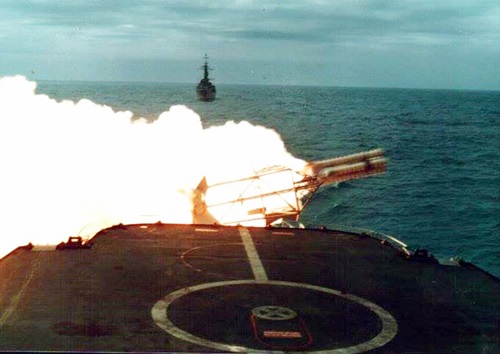
Thanks to the testimony of personnel from the GOE (Special Operations Group from the Air Force), we can understand better the situation during the attacks.
The night of the 23rd under naval artillery fire, personnel from the base while in their positions used to pop up and control where the shells were landing, after a brief pause a larger "flash" appeared in the sky, for some it was a flare, but this was speeding up towards the positions where the GOE and some mechanics were, the missile then impacting within meters of the positions. The second attack had more effect, as it took the life of 1st Lt. Castagñari, and wounded the a few men that were with him.
Its worth noting that the personnel on the ground could see the launches from their position, as the initial flash and subsequent flight was quite large. Both impacts landed close to the command post in the base, with the second missile landing closer, although the command post and the communication equipment didn't suffer any damage.
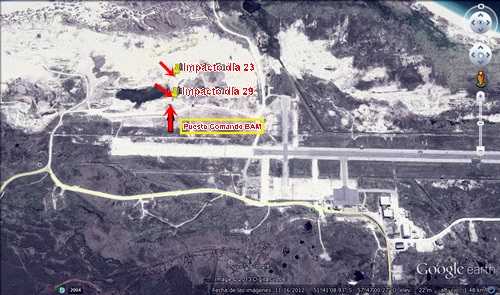
Impacts of the 23rd and 29th (the other arrow is the command post).
I wonder if the other fired at Two sisters and moody brook had any effect.
SeaslugMk2
'Curator' of the Seaslug website.
AFAIK the problem was with the Type 42's fire control system*; if a single tracked target split into two it could not decide which was the greater threat and the system crashed -this can be seen in photos/film some of the T42's in action with gun and Sea Dart launcher trained fore-and-aft.IIRC the Sea Dart back then also had trouble discriminating between two closely spaced targets causing the missile to miss both.One problem in 1982, was the Sea Dart’s proximity fuse would sense the surface of the water, so might prematurely detonate if used against a sea skimmer.
*Written in CORAL 66 as it happens.
SRJ.
Last edited:
What is the significance of that?*Written in CORAL 66 as it happens
- Joined
- 9 October 2009
- Messages
- 21,969
- Reaction score
- 13,616
Left with a couple of training rounds on the rails. Perhaps they were planning to turn her into a museum ship and she fell through the bureaucratic cracks?
- Joined
- 3 June 2011
- Messages
- 18,335
- Reaction score
- 12,233
Whoops. Yes.I assume those are Masurca SAMs and that is a decommissioned French warship?
Pirate Pete
ACCESS: Secret
- Joined
- 25 July 2007
- Messages
- 351
- Reaction score
- 585
The vessel is question is the French cruiser Colbert at the Landévennec graveyard, where there are located a number of other decommissioned French Naval vessels.
I know it is not the best source for information but: https://en.wikipedia.org/wiki/French_cruiser_Colbert_(C611)
I know it is not the best source for information but: https://en.wikipedia.org/wiki/French_cruiser_Colbert_(C611)
Maury Markowitz
From the Great White North!
- Joined
- 27 February 2014
- Messages
- 192
- Reaction score
- 144
Proportional navigation does not require the nose to be pointed at the target. In fact, that's the whole point, it naturally generates the proper lead angle with a single input.1- The missiles/system in use was the Mod 0. These were proportional navigation (aka “collision course” or “Target Referenced”). They had to continually flying such that the nose was pointing directly towards the target.
It does, however, fly the interceptor to a point in front of the target's current path. That is the problem in this case; for a sea-skimming missile, that path is close to the water and thus the issues with the fusing etc.
The description of the evasion does not match the diagram. The diagram shows the aircraft pointed towards the arrival of the missile, whereas your description would put it behind the aircraft. Perhaps the illustration is incorrect.
In either case, the "cracking" performance seems a little hyperbolic. When faced with a SAM at long range you simply want to get as far from it as possible and hope it runs out of mash. You do that by turning away and pointing the nose down for speed. I don't see anything particularly aimed at the Dart here, the exact same action would be carried out against any other SAM.
Conspirator
CLEARANCE: L5
- Joined
- 14 January 2021
- Messages
- 324
- Reaction score
- 230
very nice. i assume the polyrods were updated from the previous model as well as the guidance system?A better view of the SDView attachment 662815
- Joined
- 27 September 2006
- Messages
- 6,417
- Reaction score
- 6,815
Colbert is one of three elderly European cruisers to receive a SAM fit. The Italian Garibaldi and Netherlands De Zeven Provincien were the other two.The vessel is question is the French cruiser Colbert at the Landévennec graveyard, where there are located a number of other decommissioned French Naval vessels.
I know it is not the best source for information but: https://en.wikipedia.org/wiki/French_cruiser_Colbert_(C611)
The UK Tiger class were considered for Seaslug but rejected.
The diagram depicts a Mod.0 version (the one the Arg Navy got, thus why the Spanish writing on top), later versions received various updates to make them more capable.very nice. i assume the polyrods were updated from the previous model as well as the guidance system?A better view of the SDView attachment 662815
The vessel is question is the French cruiser Colbert at the Landévennec graveyard, where there are located a number of other decommissioned French Naval vessels.
I know it is not the best source for information but: https://en.wikipedia.org/wiki/French_cruiser_Colbert_(C611)
Colbert was retired in the early 90's. Then an association in Bordeaux turned it into a museum ship.
I visited it in 1995. I remember they had a map of Bordeaux showing range of weapons it carried : I felt it was a little morbid.
In 2007 it went bankrupt and was closed. The city was undergoing an intensive urban renewal and the big warship was hated and unwanted.
So the city got ride of it and send it back to the french navy "ghost fleet" in Brittany. The 12000 tons hull was towed there... at great pain and expense... a 600 km trip. Only for the french navy to send it to a scrapyard.
And there it becomes funny - or despairing.
The scrapper happened to be... in Bassens, which is exactly near Bordeaux, 4km away on the Garonne: essentially on the opposite river bank where Colbert stood between 1993 and 2007.
And thus the 12000 tons hulk was towed again, the exact same 600 km painful trip except in reverse, to Bassens where it was scrapped for good.
So in the end, poor Colbert crossed the Garonne river width (1 km or less) via Brittany in a 1200 km roundtrip.
And it returned to Bordeaux like a 12000 tons steel boomerang !
Colbert CA: "die hard - with a vengeance"
Bordeaux: Le Colbert arriverait mi-avril à Bassens pour sa déconstruction
Le croiseur de la Marine nationale, le Colbert, arrivera à Bordeaux probablement mi-avril pour être démantelé dans le port de Bassens pendant plus d'un an...
Last edited:
Scott Kenny
ACCESS: USAP
- Joined
- 15 May 2023
- Messages
- 11,628
- Reaction score
- 14,304
Likely.Given the events of the previous year in the Red Sea wouldn't the SM-2 and SM-6 qualify now as the most successful naval SAM?
Not to forget anything in the Persian Gulf that was involved in the Great Iranian Turkey Shoots.
Not to forget anything in the Persian Gulf that was involved in the Great Iranian Turkey Shoots.
That too plus a number of SM-3 Block IAs and Block-IIs were also fired to intercept Iranian MRBM RVs.
Last edited:
Similar threads
-
AEGIS Type Naval Air Defense in the 1960s?
- Started by Delta Force
- Replies: 8
-
-
The 12in disaster of LNT aka Admiral William Daniel Leahy's 12in LNT
- Started by Tzoli
- Replies: 2
-
-

